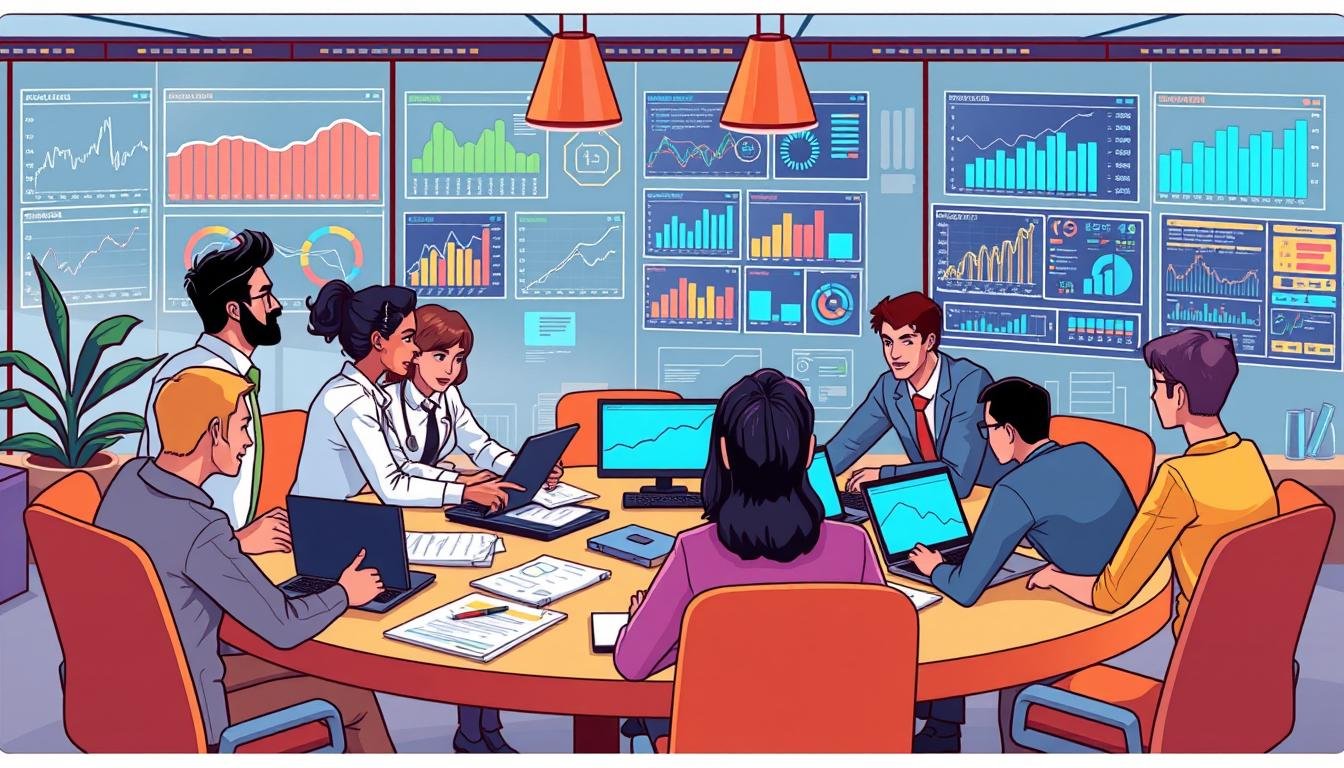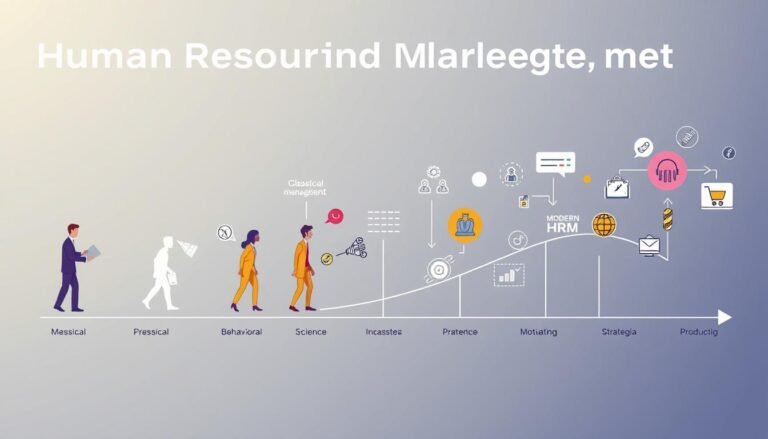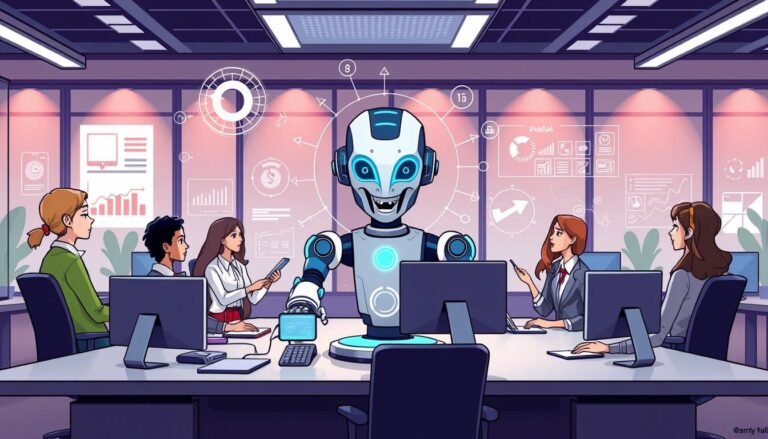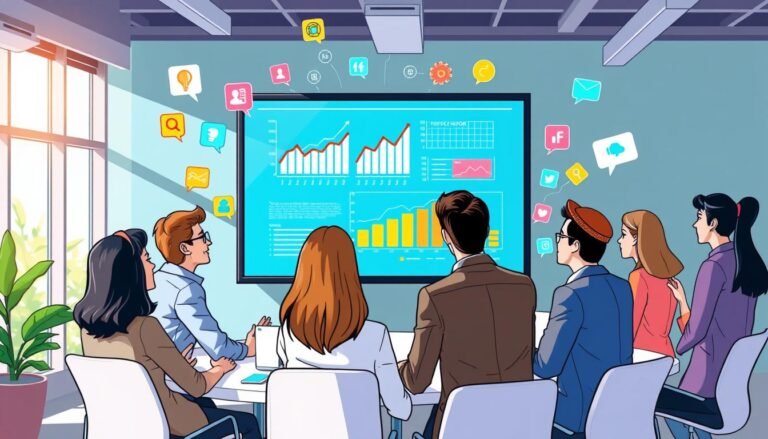Strategic Workforce Planning
Strategic workforce planning is a game-changer in Human Capital Management. It’s about getting the right people with the right skills at the right time. This process helps businesses stay ahead by aligning their workforce with future goals.
Workforce Optimization is key in today’s fast-paced world. Companies that plan their workforce strategically can adapt quickly to market changes. They’re better equipped to handle challenges and seize opportunities.
Did you know that only 18% of organizations feel they’re great at understanding future workforce needs? That’s where strategic planning comes in. It helps businesses bridge the gap between current skills and future requirements.
Key Takeaways
- Strategic workforce planning aligns employees with business goals
- It focuses on the 7 Rs: right people, skills, shape, size, time, place, and cost
- Effective planning reduces costs and improves talent management
- It helps companies adapt to market changes and demographic shifts
- Only 6% of organizations excel at enabling talent mobility
What is Strategic Workforce Planning?
Strategic workforce planning is key for companies to match their human resources with long-term goals. It looks at the current workforce and predicts future needs. This ensures the right people are in the right spots at the right time.
Definition and Importance
It’s about planning the workforce to meet future business needs. It’s more than just looking at skills and numbers now. It considers long-term goals, business strategy, and market changes. This is vital for Talent Management, helping companies get and keep the best talent, fill skill gaps, and prepare for surprises.
Key Components of Workforce Planning
Good workforce planning has several important parts:
- Supply Analysis: Looking at the current labor supply in the organization
- Demand Analysis: Predicting future workforce needs based on business goals
- Gap Analysis: Finding differences between current and future workforce needs
- Solution Analysis: Creating plans to solve these gaps
These parts work together to make a detailed Workforce Forecasting strategy. By using strategic planning and people analytics, businesses get insights into their workforce, talent gaps, and opportunities. This helps them meet their business goals.
| Planning Step | Description | Outcome |
|---|---|---|
| Supply Analysis | Assessing current workforce composition | Understanding of existing skills and capabilities |
| Demand Analysis | Forecasting future workforce needs | Projection of required skills and roles |
| Gap Analysis | Comparing current and future workforce profiles | Identification of skill deficiencies and surpluses |
| Solution Analysis | Developing strategies to address gaps | Action plan for recruiting, training, or outsourcing |
By using these key components, organizations can build a strong Human Resource Planning framework. This supports long-term success and flexibility in a changing business world.
Benefits of Strategic Workforce Planning
Strategic workforce planning brings big benefits to companies looking to improve their talent management. It helps them use a structured method to get better results. This leads to higher performance and a stronger competitive edge.
Enhanced Organizational Agility
One major plus is better organizational agility. By matching workforce plans with business goals, companies can quickly adjust to market changes. This makes them more flexible and better able to handle new challenges.
Improved Talent Management
It also makes talent management better. Focusing on hiring the right people helps build a strong talent pool. This is key for long-term success.
Succession planning is another big plus. It helps find and grow future leaders. This way, companies can avoid big problems when key people leave and make sure things keep running smoothly.
Workforce Analytics is crucial too. It uses data to help HR teams make smart choices about who to hire and train. This leads to a more efficient and productive workforce.
| Benefit | Impact |
|---|---|
| Enhanced Agility | Quick adaptation to market changes |
| Improved Talent Management | Reduced turnover, better succession |
| Data-Driven Decision Making | Optimized resource allocation |
By using strategic workforce planning, companies can build a workforce that’s strong, adaptable, and ready for success in a fast-changing world.
Steps to Implement Strategic Workforce Planning
Strategic workforce planning is key for companies to reach their future goals. A study by Oxford Economics shows only 34% of companies are ready for the future workforce. Let’s look at the main steps for effective workforce planning.
Assess Current Workforce
The first step is to do a detailed workforce analysis. This means looking at your employees’ skills, experience, and demographics. With 16% of the European Union’s workforce over 55, knowing your team’s makeup is crucial.
Identify Future Needs
Then, do a skill gap analysis to see what skills you’ll need soon. This is important, as 60% of companies say they need better planning. Think about how automation will change your roles, creating new ones in over 25% of companies.
Develop an Action Plan
After analyzing your workforce and future needs, make a talent pipeline strategy. This plan should show how to get, grow, and keep the right skills. Remember, good planning needs vision, strategy, and empathy.
| Planning Aspect | Current Status | Future Goal |
|---|---|---|
| Skill Assessment | 40% of HR leaders unaware of current skills | 100% skill visibility |
| Business Alignment | 37% of top organizations align talent with business strategy | Full alignment across all departments |
| Planning Horizon | Often short-term focused | 3-5 year strategic outlook |
By following these steps and using workforce planning tools, companies can meet their future needs. This ensures they stay ahead in a fast-changing business world.
Tools and Technologies in Workforce Planning
Workforce planning has changed a lot with new tools and technologies. These tools are key in Human Capital Management. They help organizations make better decisions for Workforce Optimization.
Workforce Analytics Software
Workforce analytics platforms are changing how companies manage talent. Tools like IBM’s Cognos Analytics and Talent Data Exchange (TDX) give important insights. TDX lets businesses try new staffing ideas and see real-time market data, which is vital for staying ahead.
Predictive Modeling Tools
Predictive modeling tools are vital for predicting future workforce needs. They use strategic planning and scenario planning to help organizations get ready for different scenarios. These tools look at past data and future plans to guide decisions on hiring, training, and keeping employees.
Other important tools include:
- 9-box grid for mapping employee performance and potential
- HR dashboards for tracking and analyzing key metrics
- Compensation and benefits analysis tools
- Learning management systems for employee development
The Performance Learning Management System (PLMS) by Acorn is a new tool to improve efficiency. By using these technologies, companies can improve their workforce planning and keep up with changes in the business world.
Challenges in Strategic Workforce Planning
Strategic workforce planning has its hurdles. These can affect how well it works. Companies face tough issues as they try to match their workforce with their goals.
Data Availability and Quality
Getting accurate, up-to-date data is a big challenge. Many companies find it hard to get all the information they need about their workforce. This makes it tough to plan for the future.
To solve this, companies are using new technology. These tools help gather and analyze data. But, setting them up can be expensive and take a lot of time.
Resistance to Change
Another big problem is people not wanting to change. Employees and managers might not want to use new methods or tools for planning. This can make it hard to improve how they manage talent.
To get past this, it’s important to talk things through clearly. HR teams should explain why new planning methods are good. Getting everyone involved can help build trust and support.
“Strategic workforce planning is like a boxing match. You need to be agile and ready to adapt to changes in the business environment.”
Other challenges include dealing with an aging workforce and keeping up with new skills. By facing these challenges head-on, companies can do better planning. This helps them get ready for what’s coming next.
Aligning Workforce Planning with Business Strategy
Strategic workforce planning is key to success. It’s not just about hiring people. It’s about making sure the right people are in the right places to meet business goals.
Understanding Organizational Goals
HR teams need to understand the company’s long-term vision. This means:
- Analyzing current and future business needs
- Assessing workforce capabilities
- Identifying skills gaps
- Developing strategies to bridge these gaps
Ensuring Alignment Across Departments
Collaboration is crucial in strategic workforce planning. HR should work with other departments to:
- Share insights on workforce trends
- Discuss future staffing needs
- Develop talent pipelines
- Allocate resources effectively
This teamwork leads to a unified approach to workforce planning. It helps achieve strategic business goals. By using data analytics and predictive modeling, companies can plan for future staffing needs.
“Strategic workforce planning is an analytics-driven process that ensures organizations acquire the right talent, at the right time, and in the right place.”
Workforce plans need regular review and updates. This keeps them in line with changing business needs. It helps avoid talent shortages and surpluses, allowing businesses to stay competitive.
Metrics to Evaluate Workforce Planning Success
Effective workforce planning needs careful measurement and analysis. By tracking key metrics, organizations can see how well their human resource planning works. This helps make data-driven decisions for talent management.
Key Performance Indicators (KPIs)
Workforce analytics are key to checking if strategic workforce planning works. Some important KPIs include:
- Employee turnover rate: (Number of exits / average headcount) × 100
- Retention rate: (Employees retained / initial headcount) × 100
- Time to fill positions: Average days to fill vacant roles
- Cost per hire: Total recruitment spend / number of hires
- Resource utilization rate: Measure of employee productivity
Employee Engagement and Retention Rates
Employee engagement and retention are key signs of workforce planning success. Organizations can track these through:
- Employee Net Promoter Score (eNPS): Gauges likelihood of recommending the company
- Absenteeism rate: (Days missed / planned work days) × 100
- Internal mobility rate: Tracks employee movement within the organization
- Diversity and inclusion metrics: Assesses representation of various groups
By watching these metrics closely, companies can improve their workforce planning. This helps in better talent management and aligns human resources with the organization’s goals.
Best Practices for Effective Workforce Planning
For manufacturing companies, strategic workforce planning is key to staying ahead. By following best practices, they can improve their talent and human capital management.
Continuous Monitoring and Adaptation
Workforce planning needs constant checking and tweaking. Companies using workforce management software get real-time data. This helps them stay compliant and efficient.
Improving manufacturing operations leads to better efficiency and quality. Companies that adjust to new workforce trends stay competitive. They also attract the best talent.
Engaging Stakeholders
It’s important to involve key stakeholders in workforce planning. Regular feedback and career growth opportunities make employees more productive. In fact, 63% of employees leave for lack of career advancement.
| Practice | Impact |
|---|---|
| Flexible work arrangements | 62% increase in employee satisfaction |
| Use of WFM solutions | 15% increase in employee productivity |
| Monthly planning process | Improved workforce demand capture |
By focusing on these best practices, companies can build a more engaged and happy workforce. This leads to success in strategic workforce planning.
The Future of Strategic Workforce Planning
Strategic workforce planning is changing fast, thanks to new tech and shifting work habits. A Deloitte survey showed only 11% of companies are really good at planning their workforce. This highlights the need for better planning in this key area.
Trends Shaping Workforce Strategies
Remote work is a big trend affecting how we plan our workforces. Gallup says 58% of U.S. workers got to choose between working from home or the office in 2022. This change means we need new ways to manage talent and plan for the future.
Companies that value diversity in their workforce are seeing big wins. McKinsey & Company found that companies with diverse teams were 36% more profitable than those without.
The Role of AI and Automation
Artificial Intelligence (AI) is changing how we plan our workforces. Deloitte says 63% of companies use AI for managing their workforces. By 2025, Gartner expects 60% of HR teams to use AI too.
AI is making workforce planning more accurate and efficient. But, there’s still room for growth. SHRM found only 12% of HR pros and 15% of workers think AI is being used well in the workplace.
Looking ahead, workforce planning will rely more on data and tech. Companies that keep up with these changes and use new tools will be ready to build strong talent pipelines and meet future needs.
Source Links
- Strategic Workforce Planning 101: Framework & Process
- What is strategic workforce planning? | Gloat
- CIPD | Workforce planning | Factsheets
- Strategic Workforce Planning: Examples + Best Practices
- Practicing the Discipline of Workforce Planning
- What Is Strategic Workforce Planning? (2024) | Visier
- Benefits of Strategic Workforce Planning in 2023 | FDM Group
- Why Strategic Workforce Planning Is More Valuable Than Ever
- Strategic Workforce Planning: Guide & Best Practices | Rippling
- 7 Steps For Successful Strategic Workforce Planning | Harver
- Workforce planning: 6 strategic steps in the right direction
- Strategic workforce planning tools: the tech changing the talent industry | Recruitment Outsourcing Specialists
- 6 Workforce Planning Tools for Your HR Strategy in 2024 | Acorn
- The Challenges and Pitfalls to Strategic Workforce Planning
- 5 Obstacles for Effective Strategic Workforce Planning | CHRO Round Table | TechWolf
- Strategic Workforce Planning – 4 Common Challenges
- Strategically Align Your Workforce With Workforce Planning |
- Council Post: 20 Tips For Aligning Workforce Planning With Organizational Strategy
- Aligning Workforce Strategies With Business Objectives
- 15 Workforce Planning Metrics: How to Measure What Matters | Runn
- 22 Crucial Workforce Planning Metrics for Your Business in 2024
- 15 Useful Metrics to Follow for Workforce Planning | ProHance
- 8 Workforce Management Best Practices + Steps
- 5 Strategic Workforce Planning Tips (2025) | Visier
- 7 Best Practices for Effective Workforce Management
- Strategic Workforce Planning: Navigating the Future of HR
- How Tech is Changing Strategic Workforce Planning
- How Strategic Workforce Planning Drives Business Outcomes








